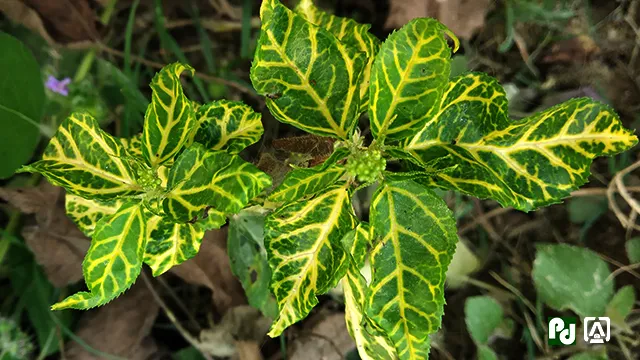Alternate host
Many pathogens have more than one host. In the absence of one host, the pathogen can survive on another host of related or unrelated plant families. Alternate hosts are the plants belonging to the unrelated family of the primary host.
Example:
In absence of okra, yellow vein mosaic virus survives in Croton and Ageratum, which are alternate hosts for the virus.
 |
| Croton is an alternate host of Bhindi Yellow Vein Mosaic Virus (BYVMV) |
Example:
In absence of okra, yellow vein mosaic virus survives in Croton and Ageratum, which are alternate hosts for the virus.
Antagonism
The tendency of an organism (here a biocontrol agent) to object or oppose the activity (growth and development) of another organism (here a pathogen) is called antagonism. In ecological sense, antagonism is negative interaction.
Disease
Any
malfunctioning of host cells and tissues that results from continuous
irritation by a pathogenic agent or environmental factor (not by direct physical injury) and leads to the development of symptoms.
Biocontrol agent
Natural enemies of pests are known as biocontrol agents or biological control agents. Biocontrol agents are any organisms, but for man itself. Biocontrol agents inhibit the growth of pests or kill them through action of competition, predation, antagonism, parasitism or hyperparasitism.
Competition
Competition is a situation, where two organisms (pests and biocontrol agents) try to get something, which is common for both. A pest and biocontrol agent compete for space and nutrition.
Disease cycle
The chain of events involved in disease development, including the
stages of development of the pathogen and the effect of the disease on the
host. Disease cycle of a pathogen includes pathogenesis, reproduction, dispersal and dormancy.
Emulsifiable Concentrate (EC)
ECs are transparent oily liquid formulations, in which pesticides or active substances are dissolved in organic solvent, such as toluene, benzene, xylene, etc. Sometimes, this may contain surfactant also. These preparations when diluted in water before application, form oil-in-water emulsion and oil contains the pesticide.
EC are prepared because the acidic salts of pesticides, which are water soluble, may react with metallic ions in the water and form precipitate and clog the spraying instruments.
EC are prepared because the acidic salts of pesticides, which are water soluble, may react with metallic ions in the water and form precipitate and clog the spraying instruments.
Epidemiology
Study of disease in plant populations. It requires biological, statistical, agronomic and ecological perspectives.
Epiphytotic
A widespread and destructive outbreak of a disease of plants (= epidemic). It can cause huge losses in yield of crops as well threatening to wipe out an entire species in the area.
Etiology
The determination and study of the cause of a disease.
Facultative parasite
A saprophyte having the ability to be a parasite.
Facultative saprophyte
A parasite with the ability to be a saprophyte. (= hemibiotrophs)
Fungicide
A compound toxic to fungi.
Fungistatic
A compound that prevents fungus growth without killing the fungus.
Inoculum
The pathogen(s) that lands on or is otherwise brought into contact with the plant is called the inoculum. The inoculum is any part of the pathogen that can initiate infection.
Intercellular
Located between the spaces of two or more cells.
Intracellular
Located within a cell.
Mycoparasite
An organism having capability of parasitizing a fungus. The phenomenon of parasitizing a fungus by other fungus is mycoparasitism. Mycoparasites are utilized as biocontrol agents.
Obligate parasite
A parasite that in nature can grow and multiply only on or in living organisms.
Obligate symbiosis
Obligate symbiosis is when one or both the symbionts can not survive without each other.
Example: Arbuscular mycorrhiza.
Parasite
An organism living on or in another living organism (host) and obtaining its food from the latter.
Pathogen
An entity that can incite disease.
Pathogenesis
The process of inciting a disease. Pathogenesis is the stage of disease in which
the pathogen is in intimate association with living host tissue.
Pathogenicity
The capability of a pathogen to cause disease.
Predation
It is a kind of harmful biological interaction, whereby an organism (Predator) kills others (Prey).
Primary infection
The first infection of a plant by the overwintering or oversummering pathogen.
Primary inoculum
The overwintering or oversummering pathogen, or its spores that cause primary
infection.
Resistant
Possessing qualities that hinder the development of a given pathogen; infected little or
not at all.
Rhizosphere
Rhizosphere is a narrow zone of soils around the roots, which is directly affected by the activities of roots. It is a highly dynamic region, where microbial populations are under high influence of root secretions.
The term rhizosphere was coined by Hilter in 1904.
The term rhizosphere was coined by Hilter in 1904.
Secondary infection
Any infection caused by inoculum produced as a result of a primary or a subsequent infection; an infection caused by secondary inoculum.
Secondary inoculum
Inoculum produced by infections that take place during the same growing
season.
Susceptible
Lacking the
inherent ability to resist disease or attack by a given pathogen; nonimmune.
Symptom
The external and internal reactions or alterations of a plant as a result of a disease.
Systemic resistance
Systemic resistance is the ability of resistant plants to de-novo synthesize certain chemicals to defend the un-affected parts of the plant far away from the site of infection.
Content first created on 01-05-2021
last updated on 25-09-2022
last updated on 25-09-2022




